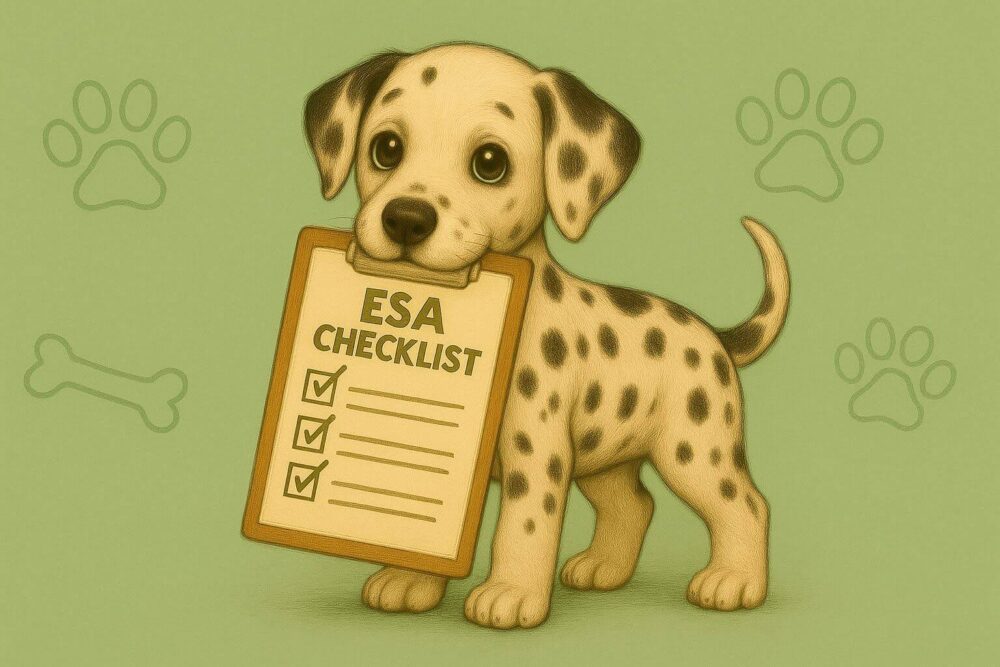
Table of Contents
Emotional support doesn’t always come from expensive therapy sessions or arrive on a leash with a wagging tail. For some of us, it fits in the palm of our hand, wiggles its nose, and squeaks at snack time.
That’s right! We’re talking about emotional support hamsters, the tiniest therapists in town. These gentle little fluffballs can make a big difference when it comes to your mental well-being. But before you start knitting a cute miniature vest for your emotional support hamster, let’s pause for a second: Can hamsters be emotional support animals?
We’ll explore that question in detail, along with the various perks of living with an ESA hamster and the steps to make it officially recognized.

Can a Hamster Be an Emotional Support Animal?
Yes, any domesticated animal can be your ESA, and that includes hamsters.
The Fair Housing Act (FHA) protects your right to live with an ESA regardless of its breed, size, or species. It doesn’t care if your emotional support animal is furry, scaly, or the size of a muffin, as long as it helps with your mental health condition.
Thanks to these strong FHA protections, people keep all sorts of unconventional critters as ESAs—from chickens to guinea pigs and even reptiles like snakes.
However, you can’t just declare your hamster a stress-relief expert and call it a day. The FHA requires an official ESA letter from a licensed mental health professional (LMHP), which basically serves as a prescription for your ESA. This letter confirms that your little whiskered therapist is more than a pet; it genuinely helps with your mental health.
Are Hamsters Good Emotional Support Animals?
Turns out, hamsters aren’t just expert wheel-runners, and they bring more to the table than just an obsession with stuffing their cheeks. Here’s why an emotional support hamster might just be perfect for you:
- Big on comfort: A hamster’s soft fur, gentle nibbles, and hilarious antics are instant mood boosters. Anxiety doesn’t stand a chance with these tiny stress-busting buddies running around you
- Apartment-approved: Hamsters take up less space than a shoebox, making them ideal for dorms, studios, or any other smaller place. A properly set-up cage is all they need—no backyard required
- Low-maintenance: Unlike dogs that need walks or cats that demand worship, hamsters are perfectly okay with a cozy cage, some fresh veggies, and the occasional chin scratch; perfect if your idea of self-care is staying in sweatpants all day
- Nighttime allies: As nocturnal creatures, hamsters are most active during evening and night hours, precisely when anxiety or depression often peaks for many people. If your brain races after dark, the gentle sound of your hamster’s late-night wheel marathons can be surprisingly soothing
Practical Considerations for Taking Care of Your ESA Hamster
Before you start picking out cute names for your pocket-sized therapist, let’s talk care. Compared to dogs or cats, hamsters have limited (but very specific) needs, and meeting them means a healthy, happy companion for you:
- Living space: Hamsters need at least 500–600 sq. in. of floor space (around the size of a standard doormat), but more space is always a plus. To avoid housing issues, make sure you can reasonably accommodate a proper setup before bringing one home
- Noise issues: Hamsters are most active after dark, and though you might find their nightly wheel marathons comforting, they can be disruptive in thin-walled apartments and maybe even keep your neighbors up. To avoid noise complaints and landlord trouble, go for a silent wheel and place the cage in a quieter corner
- Temperature control: Hamsters are temperature-sensitive creatures. They thrive in temperatures between 65–75°F, and extreme temps can seriously impact their health. If your building runs hot in summer or drafty in winter, you may need to request appropriate accommodations from your landlord to regulate the temperature for your furball
- Solitary living: Most hamsters prefer living alone, and forcing them to share space can lead to stress, fighting, or injury. If your emotional needs involve bonding with multiple animals at once, a hamster might not be the best fit. Still, their independence can be calming for many people

How To Get Your Hamster Legally Recognized as an ESA
If you’ve made up your mind to adopt a new furbaby or already have a hamster that’s handling the emotional labor, here’s how to give it the legal recognition it deserves:
- Check if you qualify for an ESA
- Get evaluated by an LMHP
- Receive an official ESA letter
- Present the letter to your landlord
Check if You Qualify for an ESA
Not everyone who loves animals or wants a pet is eligible for an emotional support animal. There needs to be a genuine medical need where your hamster’s presence helps manage your mental health condition. You need to have a qualifying condition listed in the DSM-5-TR handbook, such as:
- Anxiety disorders
- Depression
- PTSD (particularly common among military veterans)
- Bipolar disorder
- Panic disorders
- Various phobias
The good news? You don’t need to figure this out on your own. If you’re unsure about your eligibility, your LMHP can help determine whether you have a qualifying condition in the next step.
Get Evaluated by an LMHP
You need to schedule an appointment with an LMHP, such as a therapist, psychiatrist, physician, or nurse practitioner, for a professional medical evaluation. It’s important that your LMHP is licensed to practice in your specific state to comply with local laws.
This consultation can happen either in person or through telehealth—both are equally valid options under the law. The LMHP will ask basic questions about your condition, like how it impacts your daily activities and why a hamster would soothe your symptoms.
Receive an Official ESA Letter
If the LMHP approves your emotional support hamster based on their assessment, they’ll issue an official ESA letter. This document must meet specific requirements to be legally valid and protect your housing rights.
| Category | Details Required |
| Format | Official practice letterhead |
| LMHP’s details | National Provider Identifier (NPI), state license number, signature, and contact details |
| Patient confirmation | Statement about your mental health condition (doesn’t need to specify your exact diagnosis) |
| ESA recommendation | A brief description of your hamster, and that it’s part of your treatment plan |
If your letter doesn’t include all the above elements, it won’t hold up legally. That means “instant” or “free” ESA letters from websites that skip a real consultation are just templates in disguise. They might look official, but they won’t protect your rights and could even land you in legal trouble.
ESA letters are only valid when backed by an actual mental health assessment. You don’t need any ESA registration, certification, or special ID cards, despite what some fraudulent websites might advertise.
Present the Letter to Your Landlord
Once you have your official ESA letter, you can present it to your landlord and finally move in with your ESA hamster. With a legitimate letter in hand, landlords can’t reject your ESA even in pet-free buildings. You also don’t have to pay any monthly pet rent or upfront pet deposits.
Remember, landlords can’t ask invasive questions about your condition or require you to fill out additional forms for your ESA. However, they do have the right to verify your letter using the provider’s license details and credentials, which is why getting a legitimate ESA letter is non-negotiable.
Countless renters with legit ESAs get denied or evicted because they used scam letters from letter mills or fake registries. And honestly, with so many shady websites trying to make a quick buck of innocent pet owners, it can be overwhelming and outright frustrating to know where to look.
This is where Your Service Animal steps in. The service sets you up with real LMHPs who understand ESA regulations and are experienced in issuing ESA letters, so you can get your pint-sized therapist the recognition it deserves hassle-free.

Get Your Hamster’s ESA Status with Your Service Animal
Your Service Animal makes sure you’re professionally evaluated by an in-state LMHP so your letter meets all federal and state requirements. The entire process is online, so there’s no need to search for local therapists or decipher confusing regulations on your own.
Just like your hamster efficiently organizes their food stash, Your Service Animal has organized every aspect of the ESA process to work seamlessly for you:
| YSA’s Solution | What It Means for You |
| Free and quick pre-qualification quiz | Determine how likely you are to qualify for a letter in just 3 minutes, saving time and money before moving forward |
| Fully remote process | Complete everything online, from consultation to receiving your letter digitally. No need to travel or take time off work |
| Access to qualified LMHPs | Connect with vetted professionals who understand local laws and are experienced with unconventional ESAs like hamsters |
| Fast turnaround | If approved, get your letter within 24–48 hours of your consultation. This way, you can secure housing quickly and not worry about deadlines or missed opportunities |
| 100% money-back guarantee | Enjoy complete peace of mind knowing you’ll get a full refund if you’re not approved or if your letter is rejected |
Next Steps
Ready to make your hamster’s support official? Here’s how to move forward with the paperwork:
- Find out if you’re a good fit for an ESA letter with our online quiz
- Schedule an online appointment with a licensed mental health practitioner in your state
- Attend the online call and receive your ESA letter if clinically appropriate
- Receive a full refund if the therapist doesn’t issue an ESA letter or your landlord rejects your letter








